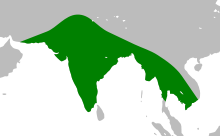Athene brama
| Spotted owlet | |
|---|---|
 |
|
|
A. b. pulchra from Singapore
A pair calling in Pune
|
|
| Scientific classification | |
| Kingdom: | Animalia |
| Phylum: | Chordata |
| Class: | Aves |
| Order: | Strigiformes |
| Family: | Strigidae |
| Genus: | Athene |
| Species: | A. brama |
| Binomial name | |
|
Athene brama (Temminck, 1821) |
|
 |
|
| Synonyms | |
|
Carine brama |
|
Carine brama
Noctua indica Franklin, 1831
The spotted owlet (Athene brama) is a small owl which breeds in tropical Asia from mainland India to Southeast Asia. A common resident of open habitats including farmland and human habitation, it has adapted to living in cities. They roost in small groups in the hollows of trees or in cavities in rocks or buildings. It nests in a hole in a tree or building, laying 3–5 eggs. They are often found near human habitation. The species shows great variation including clinal variation in size and forms a superspecies with the very similar little owl.
The spotted owlet is a small and stocky bird, barely 21 centimetres (8.3 in) in size. The upperparts are grey-brown, heavily spotted with white. The underparts are white, streaked with brown. The facial disc is pale and the iris is yellow. There is a white neckband and supercilium. Sexes are similar. The flight is deeply undulating. The nominate form is darker than the paler forms such as indica of drier regions.
Early workers sometimes treated members of this species group as subspecies of Athene noctua. The two have been separated but they are considered to form a superspecies complex. Several subspecies have been described and about four or five are widely accepted (the race poikila is invalid and refers to Aegolius funereusA. b. fryi of southern India described by Stuart Baker and A. b. mayri described by Deignan from northern Thailand are not usually recognized.). The five widely recognized subspecies are albida Koelz, 1950 of western Asia in Iran and Pakistan; indica (Franklin, 1831) of northern India; brama (Temminck, 1821) of southern India which is darker than indica; ultra Ripley, 1948 (not always recognized) of northeastern India is said to have the white spots on mantle much and "higher pitched calls"; and pulchra Hume, 1873 of Southeast Asia from Myanmar and Thailand extending into Cambodia and Vietnam. The northern and southern Indian populations intergrade and there is no dividing boundary. The northern indica populations have the upperparts brownish. Size decreases from north to south. The species is not found in Sri Lanka, although birds on the Indian mainland are found even at the tip of Rameshwaram.
...
Wikipedia

